
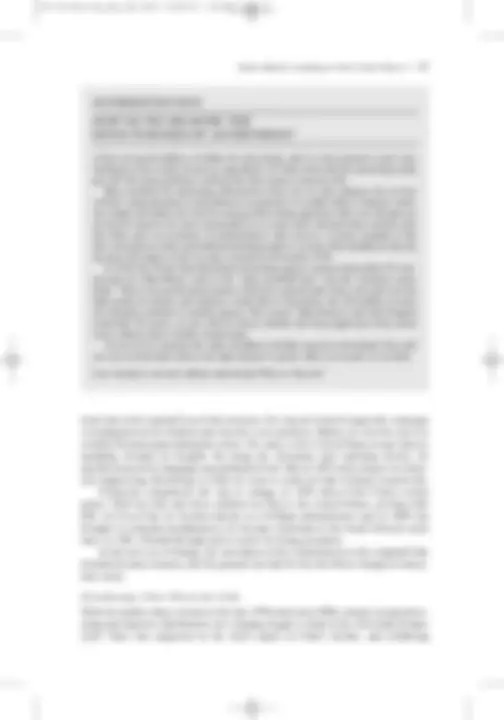
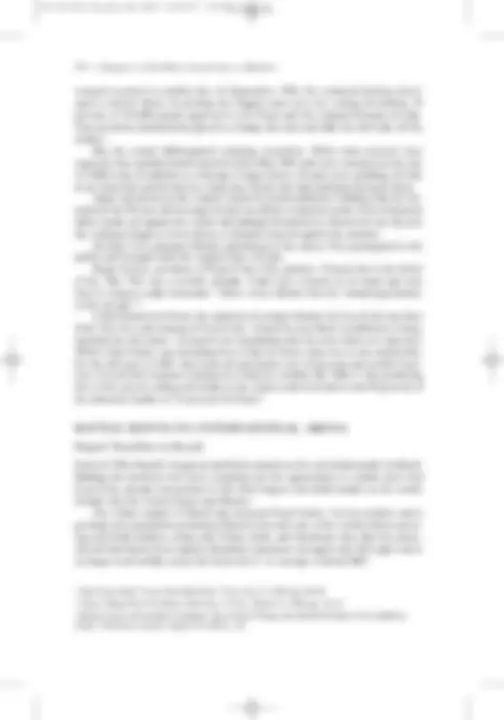
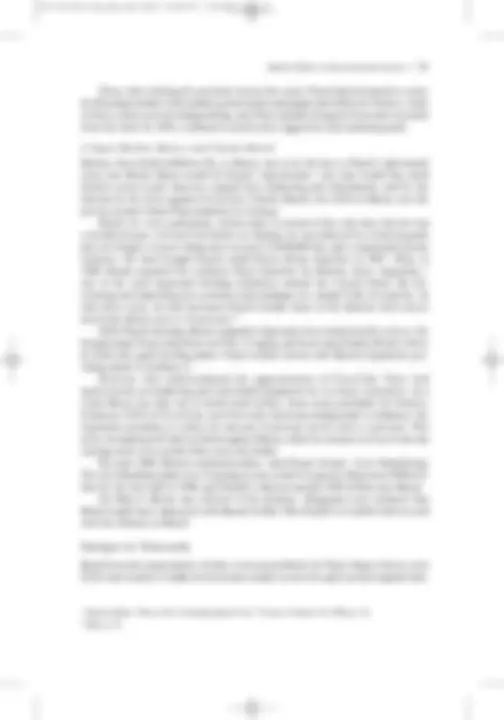
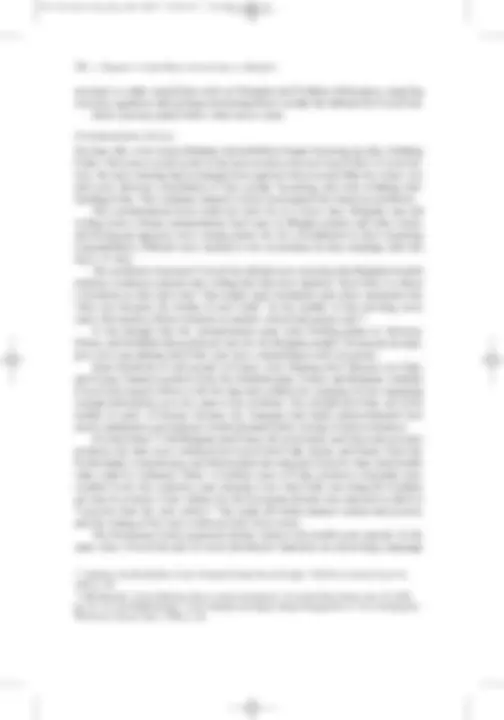
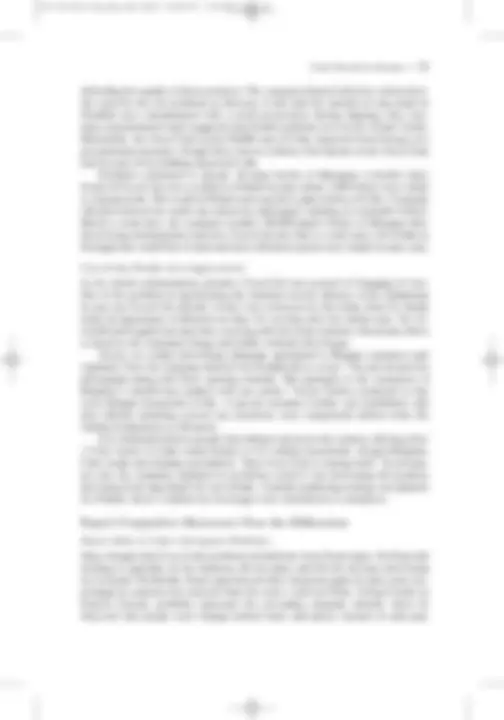
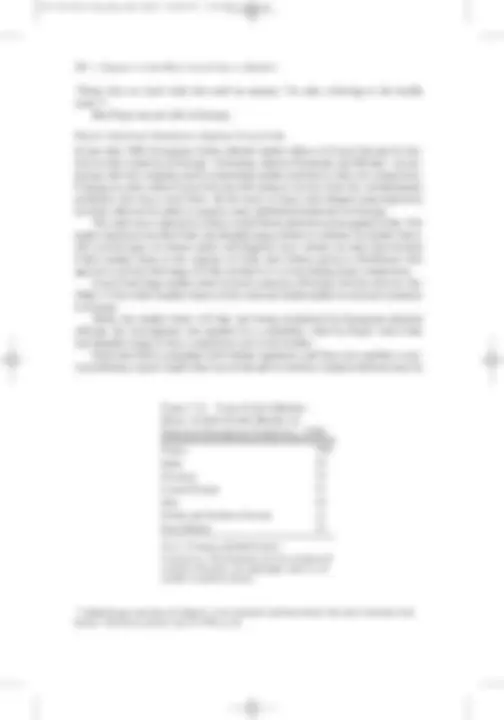
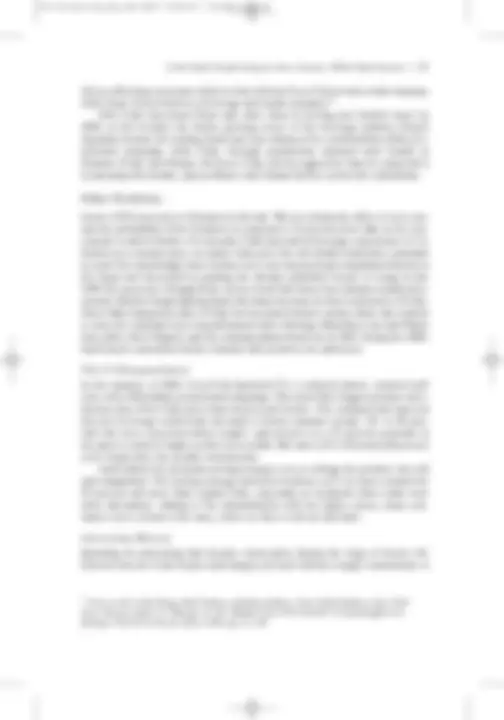
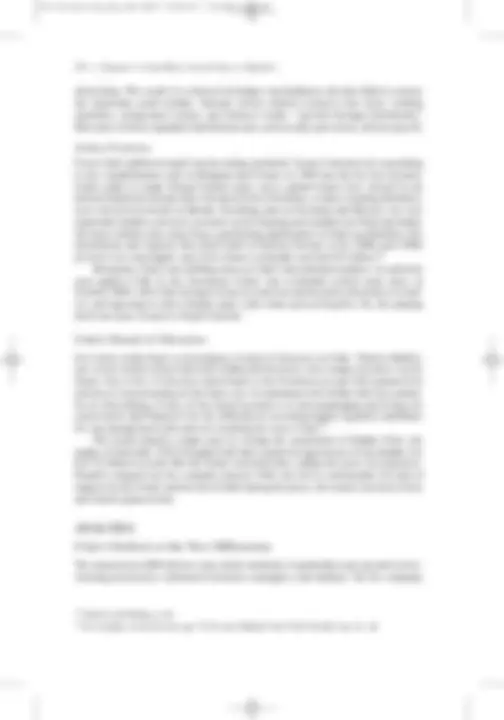
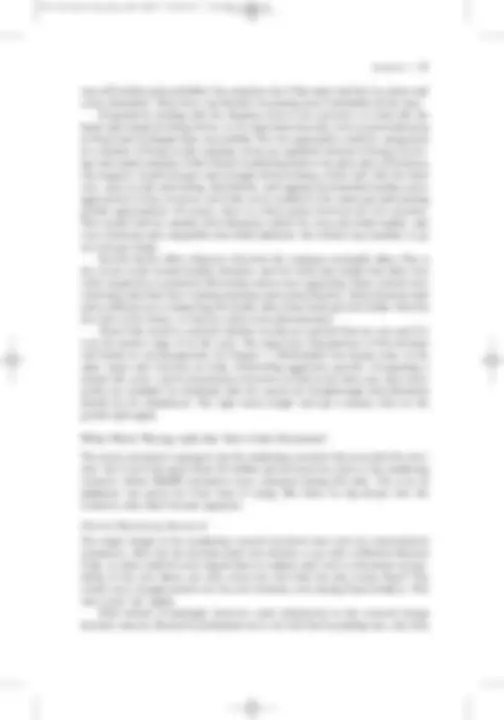
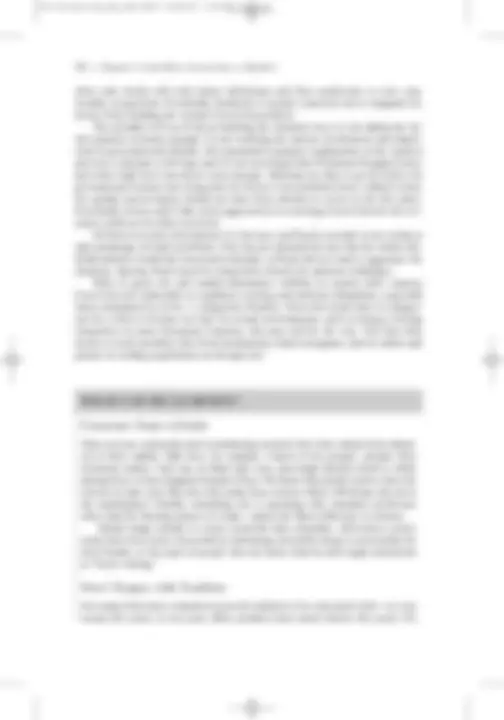

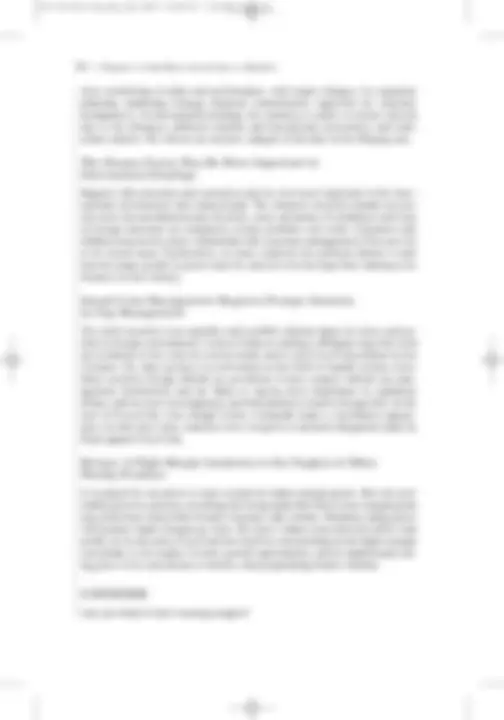
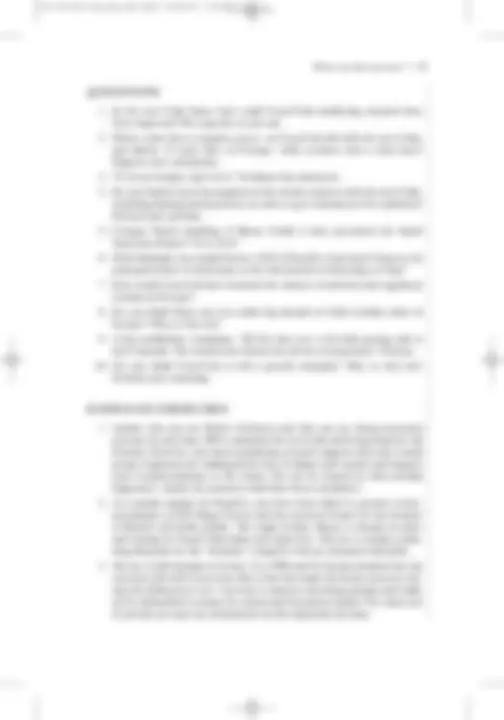
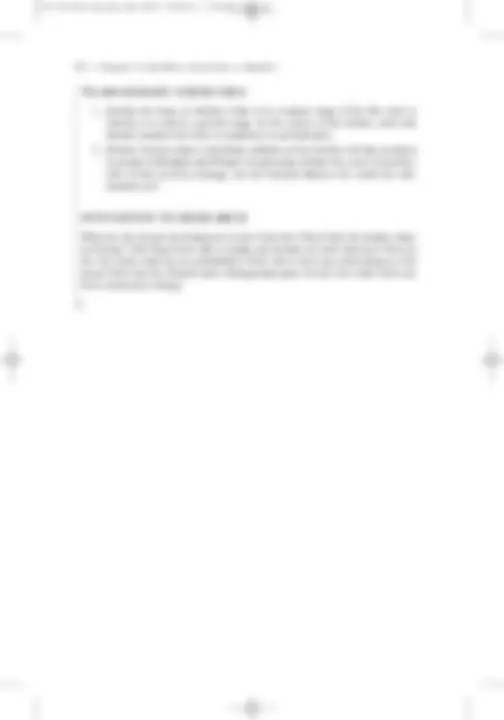


Study with the several resources on Docsity

Earn points by helping other students or get them with a premium plan


Prepare for your exams
Study with the several resources on Docsity

Earn points to download
Earn points by helping other students or get them with a premium plan
Community
Ask the community for help and clear up your study doubts
Discover the best universities in your country according to Docsity users
Free resources
Download our free guides on studying techniques, anxiety management strategies, and thesis advice from Docsity tutors
Intense competition between Pepsi and Coca-Cola has characterized the soft-drink industry for decades. In this chess game of giant firms, Coca-Cola ruled ...
Typology: Study notes
1 / 22

This page cannot be seen from the preview
Don't miss anything!















industry for decades. In this chess game of giant firms, Coca-Cola ruled the soft-drink market throughout the 1950s, 1960s, and early 1970s. It outsold Pepsi two to one. But this was to change. Then the chess game, or “war,” switched to the international arena, and it became a “world war.”
By the mid-1970s, the Coca-Cola Company was a lumbering giant. Performance reflected this. Between 1976 and 1978, the growth rate of Coca-Cola soft drinks dropped from 13 percent annually to a meager 2 percent. As the giant stumbled, Pepsi Cola was finding heady triumphs. First came the “Pepsi Generation.” This advertising campaign captured the imagination of the baby boomers with its idealism and youth. This association with youth and vitality greatly enhanced the image of Pepsi and firmly associated it with the largest consumer market for soft drinks. Then came another management coup, the “Pepsi Challenge,” in which com- parative taste tests with consumers showed a clear preference for Pepsi. This cam- paign led to a rapid increase in Pepsi’s market share, from 6 to 14 percent of total U.S. soft-drink sales. Coca-Cola, in defense, conducted its own taste tests. Alas, these tests had the same result—people liked the taste of Pepsi better, and market-share changes reflected this. As Table 3.1 shows, by 1979, Pepsi was closing the gap on Coca-Cola, having 17.9 percent of the soft-drink market, to Coke’s 23.9 percent. By the end of 1984, Coke had only a 2.9 percent lead, while in the grocery store market it was now trailing by 1.7 percent. Further indication of the diminishing position of Coke rela- tive to Pepsi was a study done by Coca-Cola’s own marketing research department. The study showed that in 1972, 18 percent of soft-drink users drank Coke exclusively, while only 4 percent drank only Pepsi. In 10 years the picture had changed greatly:
Only 12 percent now claimed loyalty to Coke, while the number of exclusive Pepsi drinkers almost matched, with 11 percent. Figure 3.1 shows this change graphically. What made the deteriorating comparative performance of Coke all the more worrisome and frustrating to Coca-Cola was that it was outspending Pepsi in adver- tising by $100 million. It had twice as many vending machines, dominated fountains, had more shelf space, and was competitively priced. Why was it losing market share? The advertising undoubtedly was not as effective as that of Pepsi, despite vastly more money spent. And this raises the question: How can we measure the effectiveness of advertising? See the following Information Box for a discussion.
The Changing of the Guard at Coke
J. Paul Austin, chairman of Coca-Cola, was nearing retirement in 1980. Donald Keough, president for the American group, was expected to succeed him. But a new name, Roberto Goizueta, suddenly emerged. Goizueta’s background was far different
32 • Chapter 3: Cola Wars: Coca-Cola vs. PepsiCo
TABLE 3.1 Coke and Pepsi Shares of Total Soft-Drink Market, 1950s–
1975 1979 1984 % of % of % of Mid-1950s Lead Market Lead Market Lead Market Lead
Coke Better than 2 to 1 24.2 6.8 23.9 6.0 21.7 2. Pepsi 17.4 17.9 18.
Source: Thomas Oliver, The Real Coke. The Real Story (New York: Random House, 1986), pp. 21, 50; “Two Cokes Really Are Better Than One—For Now,” Business Week, 9 September 1985, p. 38.
Figure 3.1 Coke versus Pepsi: Comparison of exclusive drinkers, 1972 and 1982.
research seemed to confirm this. In September 1984, the technical division devel- oped a sweeter flavor. In perhaps the biggest taste test ever, costing $4 million, 55 percent of 191,000 people approved it over Pepsi and the original formula of Coke. Top executives unanimously agreed to change the taste and take the old Coke off the market. But the results flabbergasted company executives. While some protests were expected, they quickly mushroomed; by mid-May 1985 calls were coming in at the rate of 5,000 a day, in addition to a barrage of angry letters. People were speaking of Coke as an American symbol and as a long-time friend who had suddenly betrayed them. Anger spread across the country, fueled by media publicity. Fiddling with the for- mula for the 99-year-old beverage became an affront to patriotic pride. Even Goizueta’s father spoke out against the switch and jokingly threatened to disown his son. By now the company began to worry about a consumer boycott against the product. On July 11th company officials capitulated to the outcry. They apologized to the public and brought back the original taste of Coke. Roger Enrico, president of Pepsi-Cola, USA, gloated, “Clearly this is the Edsel of the ’80s. This was a terrible mistake. Coke’s got a lemon on its hand and now they’re trying to make lemonade.” Other critics labeled this the “marketing blunder of the decade.” 1 Unfortunately for Pepsi, the euphoria of a major blunder by Coca-Cola was short lived. The two-cola strategy of Coca-Cola—it kept the new flavor in addition to bring- ing back the old classic—seemed to be stimulating sales far more than ever expected. While Coke Classic was outselling New Coke by better than two to one nationwide, for the full year of 1985, sales from all operations rose 10 percent and profits 9 per- cent. Coca-Cola’s fortunes continued to improve steadily. By 1988, it was producing five of the top-ten selling soft drinks in the country and now had a total 40 percent of the domestic market to 31 percent for Pepsi. 2
Early in 1994, PepsiCo began an ambitious assault on the soft-drink market in Brazil. Making this invasion even more tempting was the opportunity to combat arch-rival Coca-Cola, already entrenched in this third largest soft-drink market in the world, behind only the United States and Mexico. The robust market of Brazil had attracted Pepsi before. Its hot weather and a growing teen population positioned Brazil to become one of the world’s fastest-grow- ing soft-drink markets, along with China, India, and Southeast Asia. But the poten- tial still had barely been tapped. Brazilian consumers averaged only 264 eight-ounce servings of soft drinks a year, far below the U. S. average of about 800. 3
34 • Chapter 3: Cola Wars: Coca-Cola vs. PepsiCo
(^1) John Greenwald, “Coca-Cola’s Big Fizzle,” Time, July 22, 1985, pp. 48–49. (^2) “Some Things Don’t Go Better with Coke,” Forbes, March 21, 1988, pp. 34–35. (^3) Robert Frank and Jonathan Friedland, “How Pepsi’s Charge into Brazil Fell Short of Its Ambitious Goals,” Wall Street Journal, August 30, 1996, p. A1.
Three times during the previous twenty-five years, Pepsi had attempted to enter the Brazilian market with splashy promotional campaigns and different bottlers. Each of these efforts proved disappointing, and Pepsi quickly dropped them and retreated from the field. In 1994, it planned a much more aggressive and enduring push.
A Super Bottler, Baesa, and Charles Beach
Buenos Aires Embotelladora SA, or Baesa, was to be the key to Pepsi’s rejuvenated entry into Brazil. Baesa would be Pepsi’s “superbottler,” one that would buy small bottlers across Latin America, expand their marketing and distribution, and be the fulcrum in the drive against Coca-Cola. Charles Beach, the CEO of Baesa, was the person around whom Pepsi planned its strategy. Beach, 61, was a passionate, driven man, a veteran of the cola wars, but his was a checkered past. A Coca-Cola bottler in Virginia, he was indicted by a federal grand jury on charges of price fixing and received a $100,000 fine and a suspended prison sentence. He then bought Pepsi’s small Puerto Rican franchise in 1987. Then, in 1989, Beach acquired the exclusive Pepsi franchise for Buenos Aires, Argentina— one of the most important bottling franchises outside the United States. By dis- counting and launching new products and packages, he caught Coke by surprise. In only three years, he had increased Pepsi’s market share in the Buenos Aires metro area from almost zero to 34 percent. 4 With Pepsi’s blessing, Beach expanded vigorously, borrowing heavily to do so. He bought major Pepsi franchises in Chile, Uruguay, and most importantly, Brazil, where he built four giant bottling plants. Pepsi worked closely with Baesa’s expansion, pro- viding funds to facilitate it. However, they underestimated the aggressiveness of Coca-Cola. Their rival spent heavily on marketing and cold-drink equipment for its choice customers. As a result Baesa was shut out of small retail outlets, those most profitable for bottlers. Goizueta, CEO of Coca-Cola, used his Latin American background to influence the Argentine president to reduce an onerous 24 percent tax on cola to 4 percent. This move strengthened Coke’s position against Baesa, which in contrast to Coca-Cola was earning most of its profits from non-cola drinks. By early 1996, Baesa’s expansion plans—and Pepsi’s dream—were floundering. The new Brazilian plants were running at only a third of capacity. Baesa lost $300 mil- lion for the first half of 1996, and PepsiCo injected another $40 million into Baesa. On May 9, Beach was relieved of his position. Allegations now surfaced that Beach might have tampered with Baesa’s books. 5 But PepsiCo’s troubles did not end with the debacle in Brazil.
Brazil was only symptomatic of other overseas problems for Pepsi. Roger Enrico, now CEO, had reasons to shake his head and wonder at how the gods seemed against him.
Battle Shifts to International Arena • 35
(^4) Patrica Sellers, “How Coke Is Kicking Pepsi’s Can,” Fortune, October 28, 1996, p. 78. (^5) Ibid, p. 79.
business. But 95 percent of the world doesn’t live here.”^10 And Pepsi seemed unable to hold its own against Coke in this world market.
In early 1998, Douglas Ivester took over as chairman and chief executive of Coca- Cola. He had a tough act to follow, being the successor to the legendary Goizuerta. Things seemed to go downhill from then on, but it was not entirely his fault. The first quarter of 1999 witnessed a sharp slowdown in Coca-Cola’s North American busi- ness, at least partly due to price increases designed to overcome weakness resulting from overseas economic woes. While most analysts thought the sticker shock of higher prices would be temporary, some thought the company needed to be more innovative, needed to do more than offer super-size drinks. 11 Other problems emanated from a racial discrimination lawsuit, as well as Mr. Ivester’s “brassy”
Coke Travails in Europe, 1999 • 37
TABLE 3.2 Coke and Pepsi Shares of Total Soft-Drink Sales, Top Ten Markets, 1996 Market Shares Markets Coke Pepsi United States 42% 31% Mexico 61 21 Japan 34 5 Brazil 51 10 East-Central Europe 40 21 Germany 56 5 Canada 37 34 Middle East 23 38 China 20 10 Britain 32 12 Source: Company annual reports, and Patricia Sellers, “How Coke Is Kicking Pepsi’s Can,” Fortune, 28 October 1996, p. 82. Commentary: These market share comparisons show the extent of Pepsi’s ineptitude in its international markets. In only one of these top 10 overseas markets is it ahead of Coke, and in some, such as Japan, Germany, and Brazil, it is practically a nonplayer.
(^10) Frank, p. C2. (^11) Nikhil Deogun, “Coke’s Slower Sales Are Blamed on Price Increases,” Wall Street Journal, March 31, 1999, pp. A3, A4.
attempts to make acquisitions such as Orangina and Cadbury Schweppes, angering overseas regulators and perhaps motivating them to make life difficult for Coca-Cola. Such concerns paled before what was to come.
Contamination Scares
On June 8th, a few dozen Belgian schoolchildren began throwing up after drinking Cokes. This was to result in one of the most serious crises in Coca-Cola’s 113-year his- tory. An early warning had seemingly been ignored when in mid-May the owner of a pub near Antwerp complained of four people becoming sick from drinking bad- smelling Coke. The company claimed to have investigated but found no problems. The contamination news could not have hit at a worse time. Belgium was still reeling from a dioxin-contamination food scare in Belgian poultry and other foods, and European agencies were coming under fire for a breakdown in their watchdog responsibilities. Officials were inclined to be overzealous in their dealings with this big U. S. firm. The problems worsened. Coca-Cola officials were meeting with Belgium’s health minister, seeking to placate him, telling him that their analyses “show that it is about a deviation in taste and color” that might cause headaches and other symptoms but “does not threaten the health of your child.” In the middle of this meeting, news came that another fifteen students at another school had gotten sick. 12 It was thought that the contamination came from bottling plants in Antwerp, Ghent, and Dunkirk that produced cans for the Belgium market. European newspa- pers were speculating that Coke cans were contaminated with rat poison. Soon hundreds of sick people in France were blaming their illnesses on Coke, and France banned products from the Dunkirk plant. France and Belgium rebuffed Coca-Cola’s urgent efforts to lift the ban and scolded the company for not supplying enough information as to the cause of the problem. The setback left Coke out of the market in parts of Europe because the company had badly underestimated how much explanation governments would demand before letting it back in business. Not until June 17 did Belgium and France lift restrictions, and then only on some products; the bans were continued on Coca-Cola’s Coke, Sprite, and Fanta. Then the Netherlands, Luxembourg, and Switzerland also imposed selective bans until health risks could be evaluated. Some 14 million cases of Coke products eventually were recalled in the five countries, and estimates were that Coke was losing $3.4 million per day in revenues. Case volume for the European division was expected to fall 6 to 7 percent from the year earlier. 13 The peak soft-drink summer season had arrived, and the timing of the scare could not have been worse. The European Union requested further study as the health scare spread. At the same time, Coca-Cola and its local distributors launched an advertising campaign
38 • Chapter 3: Cola Wars: Coca-Cola vs. PepsiCo
(^12) “Anatomy of a Recall: How Coke’s Controls Fizzled Out in Europe,” Wall Street Journal, June 29, 1999, p. A6. (^13) Will Edwards, “Coke Chairman Tries to Assure Europeans,” Cleveland Plain Dealer, June 19, 1999, pp. C1, C3; and Nikhil Deogun, “Coke Estimates European Volume Plunged 6% to 7% in 2nd Quarter,” Wall Street Journal, July 1, 1999, p. A4.
“That’s why we don’t wish this stuff on anyone,” he said, referring to the health scare.^14 But Pepsi was not idle in Europe.
Pepsi’s Antitrust Initiatives Against Coca-Cola
In late July 1999, European Union officials raided offices of Coca-Cola and its bot- tlers in four countries in Europe—Germany, Austria, Denmark, and Britain—on sus- picions that the company used its dominant market position to shut out competitors. Coming at a time when Coca-Cola was still trying to recover from the contamination problems, this was a cruel blow. All the more so since such alleged noncompetitive activities affected its plans to acquire some additional businesses in Europe. The raids were expected to lead to a full-blown antitrust action against Coke. The major suspicion was that Coke was illegally using rebates to enhance its market share. The several types of rebates under investigation were rebates on sales that boosted Coke’s market share at the expense of rivals, and rebates given to distributors who agreed to sell the full range of Coke products or to stop buying from competitors. Coca-Cola’s huge market share in most countries of Europe fed the concern. See Table 3.3 for Coke’s market shares of the total soft-drink market in selected countries in Europe. While the market share of Coke was being scrutinized by European antitrust officials, the investigation was sparked by a complaint—filed by Pepsi—that Coke was illegally trying to force competitors out of the market. Pepsi also filed a complaint with Italian regulators, and they were quicker to act. A preliminary report found that Coca-Cola and its bottlers violated antitrust laws by
40 • Chapter 3: Cola Wars: Coca-Cola vs. PepsiCo
(^14) Nikhil Deogun and James R. Hagerty, “Coke Scandal Could Boost Rivals, But Also Could Hurt Soft Drinks,” Wall Street Journal, June 23, 1999, p. A4.
TABLE 3.3 Coca-Cola’s Market Share of Soft-Drink Market in Selected European Countries, 1998 France 59% Spain 58 Germany 55 Central Europe 47 Italy 45 Nordic and Northern Eurasia 41 Great Britain 35 Source: Company published reports. Commentary: The dominance of Coke in almost all countries of Europe, not surprisingly, makes it vul- nerable to antitrust scrutiny.
abusing a dominant market position through practices such as discounts, bonuses, and exclusive deals with wholesalers and retailers. The Italian regulators also said there was evidence that Coke had a “strategic plan” to remove Pepsi from the Italian market, one of the biggest in Europe, by paying wholesalers to remove Pepsi foun- tain equipment and replace it with Coke. At about this time, Australian and Chilean officials also began conducting informal inquiries in their markets. Coca-Cola officials responded to the Italian report as follows: “We believe this is a baseless allegation by Pepsi and we believe that Pepsi’s poor performance in Italy is due to their lack of commitment and investment there. As a result, they are attempt- ing to compete with us in the courtroom instead of the marketplace.” 15
For decades, Coca-Cola was a premier growth company with some of the best-known brands in the world, and management seemed well positioned to take advantage of the global economy. But we have just seen lapses in the late 1990s, particularly in handling contamination problems in Europe and in dealing with antitrust charges there. Going into the new century, the new millennium, problems seemed more sub- tle but with longer lasting concerns. Not that the old esteemed company was wither- ing away, but rather that it faced a slowing growth trend. For example, Coke gener- ated average annual earnings growth of 18 percent between 1990 and 1997. In recent years, its net income grew at just a 4 percent average. Share prices had fallen hard, in 2004 trading at less than half their 1998 peak. At the same time, PepsiCo, while it never quite caught Coke in the cola wars, outdid its rival in overall business growth. The following comparative statistics show the slipping performance of Coca-Cola to PepsiCo over the five years to 2004.
Part of the problem facing Coke was an industry problem, but with its heavy emphasis on carbonated soft drinks, it became worse for Coke than for Pepsi. Consumers, more concerned with health and obesity, were seeking new kinds of
Coke Pepsi Sales 2003 $21 billion $27 billion Sales growth (5-year average) 2% 4% Earnings $4.3 billion $3.6 billion Earnings growth (5-year average) 4% 12% Stock price (5 years ending 12/3/04) – 40% 38% Source: Bloomberg Financial Markets as reported in Dean Foust, “Gone Flat,” Business Week, December 20, 2004, p. 82.
Coke Finds Tough Going in New Century While Pepsi Surges • 41
(^15) Betsy McKay, “Coke, Bottlers Violated Antitrust Laws in Italy, a Preliminary Report States,” Wall Street Journal, August 13, 1999, p. A4.
sify as reflecting a corporate mind-set that still saw Coca-Cola as only a soda company, while Pepsi viewed itself as a beverage-and-snack company.^17 Still, Coke had joined Pepsi and other firms in moving into bottled water by 2003, as this became the fastest growing sector of the beverage industry. Pepsi’s Aquafina became the leading brand and was enhanced by a multimillion-dollar pro- motional campaign, while Coke, through acquisitions, amassed such brands as Dannon, Evian, and Dasani. However, Coke was less aggressive than its competitors in pursuing this market, and problems with Dasani further cooled the enthusiasm.
Ivester, CEO successor to Goizueta in the late ’90s, in a desperate effort to try to sus- tain the profitability of the Goizueta era, imposed a 7.6 percent price hike on the con- centrate it sold its bottlers. For decades, Coke had sold its beverage concentrate to U.S. bottlers at a constant price, no matter what price the soft drinks would later command at retail. Not surprisingly, these bottlers were now incensed and complained bitterly to the board and succeeded in pushing the already embattled Ivester to resign in late
The C2 Disappointment
In the summer of 2003, Coca-Cola launched C2, a reduced-calorie, reduced-carb cola, with a $50 million promotional campaign. This was Coke’s biggest product intro- duction since Diet Coke more than twenty years before. The company had expected this new beverage would help win back a critical consumer group—20- to 40-year- olds who were concerned about weight—and priced it at a 15 percent premium in the quest to achieve higher profits on its drinks. But sales of C2 fell nearly 60 percent a few weeks after the product introduction. Isdell halted the premium pricing strategy to try to salvage the product, but still sales languished. The pricing strategy had been botched, as C2 at times retailed for 50 percent and more than regular Coke, especially on weekends when sodas were often discounted. Adding to the dissatisfaction with the higher prices, many con- sumers were critical of the taste, either too flat or with an aftertaste.
Advertising Miscues
Spending for advertising had become conservative during the reign of Ivester. He believed that the Coke brand could largely sell itself without a major commitment to
Coke Finds Tough Going in New Century While Pepsi Surges • 43
(^17) Foust, p. 80; Leslie Chang, Chad Terhune, and Betsy McKay, “Coke’s Big Gamble in Asia,” Wall Street Journal, August 11, 2004, pp. A1, A6; “Behind Coke’s CEO Travails: A Long Struggle Over Strategy,” Wall Street Journal, May 4, 2004, pp. A1, A10.
advertising. The result of a reduced ad budget was lackluster ads that failed to attract the important youth market. Instead, Ivester shifted resources into more vending machines, refrigerated coolers, and delivery trucks—”growth through distribution.” But some of these expanded distribution sites, such as auto part stores, did not pay off.
Global Problems
Even Coke’s global strength was becoming tarnished. Ivester’s slowness in responding to the contamination scare in Belgium and France in 1999 was but the first misstep. Coke’s plans to make Dasani bottled water into a global brand were slowed by an aborted launch in Europe after elevated levels of bromate, a cancer-causing substance, were detected in bottles in Britain. Declining sales in Germany and Mexico, two very important markets, put more pressure on developing such markets as China and India. Yet these looked years away from contributing significantly to Coke’s profitability. The distribution and capacity that Isdell built in Eastern Europe in the 1980s and 1990s proved to be extravagant, and write downs eventually exceeded $1 billion.^18 Meantime, Pepsi was nibbling away at Coke’s international markets. Its antitrust case against Coke in the European Union was eventually settled years later, in October 2004, with Coke having to drop its controversial incentive discounts to retail- ers, and agreeing to share display space with rivals such as PepsiCo. So, the playing field was more leveled to Pepsi’s benefit.
Few firms could boast as prestigious a board of directors as Coke. Warren Buffett, one of the world’s richest and most influential investors, was a major presence on the board. Ten of the 14 directors dated back to the Goizueta era and still espoused his policies of concentrating on the basic core of carbonated soft drinks with less empha- sis on diversifying. Critics of the board accused it of micromanaging and being too conservative and blamed it for the difficulty in recruiting highly regarded candidates for top management jobs and not retaining the ones it had. 19 The board played a major part in vetoing the acquisition of Quaker Oats, the maker of Gatorade. CEO Douglas Daft had reached an agreement to buy Quaker for $15.75 billion in stock. But the board overruled him, calling the price too expensive. PepsiCo snapped up the company instead. Daft was left to contemplate his lack of support by the board, and his loss of faith among his peers. He tenure was short lived, and Isdell replaced him.
The situation by 2005 did not come about suddenly. It gradually crept up until a dete- riorating stock price confronted investors, managers, and analysts. Yet the company
44 • Chapter 3: Cola Wars: Coca-Cola vs. PepsiCo
(^18) Terhune and McKay, p. A6. (^19) For example, see Dean Foust, pp. 79, 82; and “Behind Coke’s CEO Travails,” pp. A1, A6.
would lose the other. This proved to be a significant distortion: Any addition to the product line would naturally be far more acceptable than completely eliminating the traditional product. While three to four new tastes were tested with almost 200,000 people, only 30,000 to 40,000 of these testers tried the specific formula for the new Coke. Research was geared more to the idea of a new, sweeter cola than that used in the final formula. In general, a sweeter flavor tends to be preferred in blind taste tests. This is particularly true with youths, the largest drinkers of sugared colas and the very group drinking more Pepsi in recent years. Interestingly, preference for sweeter tast- ing products tends to diminish with use.^20 Consumers were asked whether they favored change as a concept, and whether they would likely drink more, less, or the same amount of Coke if there were a change. But such questions could hardly prove the depth of feelings and emotional ties to the product.
Symbolic Value
The symbolic value of Coke was the sleeper. Perhaps this should have been foreseen. Perhaps the marketing research should have considered this possibility and designed the research to map it and determine the strength and durability of these values— that is, would they have a major effect on any substitution of a new flavor? Admittedly, when we get into symbolic value and emotional involvement, any researcher is dealing with vague attitudes. But various attitudinal measures have been developed that can measure the strength or degree of emotional involvement.
Herd Instinct
Here we see a natural human phenomenon, the herd instinct, the tendency of peo- ple to follow an idea, a slogan, a concept, to “jump on the bandwagon.” At first, acceptance of new Coke appeared to be reasonably satisfactory. But as more and more outcries were raised—fanned by the media—about the betrayal of the old tra- dition (somehow this became identified with motherhood, apple pie, and the flag), public attitudes shifted strongly against the perceived unworthy substitute. The bandwagon syndrome was fully activated. It is doubtful that by July 1985 Coca-Cola could have done anything to reverse the unfavorable tide. To wait for it to die down was fraught with danger—for who would be brave enough to predict the durability and possible heights of such a protest movement? Could, or should, such a tide have been predicted? Perhaps not, at least regard- ing the full strength of the movement. Coca-Cola expected some protests. But per- haps it should have been more cautious by considering a worst-case scenario in addi- tion to what seemed the more probable, and by being better prepared to react to such a contingency.
46 • Chapter 3: Cola Wars: Coca-Cola vs. PepsiCo
(^20) “New Cola Wins Round 1, But Can It Go the Distance?” Business Week, June 24, 1985, p. 48.
Pepsi’s Defeats in South America
With hindsight, we can identify many of the mistakes Pepsi made. It tried to expand too quickly in Argentina and Brazil, imprudently putting all its chips on a distributor with a checkered past, instead of building up relationships slower and more carefully. It did not monitor foreign operations closely enough or soon enough to prevent rash expansion of facilities and burdensome debt accumulations by affiliates. It did not lis- ten closely enough to old distributors and their changing wants, and so lost Venezuela to Coca-Cola. Pepsi apparently did not learn from its past mistakes: For example, three times before, it had tried to enter Brazil and had failed. Why the failures? Why was it not more careful to prevent failure the next time? Finally, we can speculate that maybe Pepsi was not so bad, but rather that its major competitor was so good. Coca-Cola had slowly built up close relationships with foreign bottlers over decades. It was aggressive in defending its turf. Perhaps not the least of its strengths, at least in the lucrative Latin American markets, was a CEO who was also a Latino, could speak Spanish and share the concerns, and build on the egos of its local bottlers. In selling, this is known as a dyadic relationship, and it is discussed further in the following Information Box. After all, why can’t a CEO do a selling job on a distributor and capitalize on a dyadic relationship?
Coca-Cola’s Problems in Europe
Could Coca-Cola have handled the Belgian crisis better? With hindsight, we see a flawed initial reaction. Still, the first incident of 24 schoolchildren getting ill and throwing up after drinking Coke seemed hardly a major crisis at the time. But crises
Analysis • 47
Sellers are now recognizing the importance of the buyer-seller interaction, a dyadic rela- tionship. A transaction, negotiation, or relationship can often be helped by certain char- acteristics of the buyer and seller in the particular encounter. Research suggests that salespeople tend to be more successful if they have characteristics similar to their cus- tomers in age, size, and other demographic, social, and ethnic variables. Of course, in the selling situation, this suggests that selecting and hiring sales appli- cants most likely to be successful might require careful study of the characteristics of the firm’s customers. Turning to the Pepsi/Coke confrontation in Brazil and Venezuela, the same concepts should apply and give a decided advantage to Coca-Cola and Roberto Goizueta in influencing government officials and local distributors. After all, in interact- ing with customers and affiliates, even a CEO needs to be persuasive in presenting ideas as well as handling problems and objections. Can you think of any situations where the dyadic theory may not work?
other product has been so widely used and so deeply entrenched in societal values and culture as Coke. The psychological components of the great Coke protest make interesting speculation. Perhaps in an era of rapid change, many people wish to hang on to the one symbol of security or constancy in their lives—even if it’s only the tradi- tional Coke flavor. Perhaps many people found this protest to be an interesting way to escape the humdrum, by making waves in a rather harmless way, in the process of seeing if a big corporation might be forced to cry “uncle.” One is left to wonder how many consumers would even have been aware of any change in flavor had the new formula been quietly introduced without fanfare. But, of course, the advertising siren call of “New” would have been muted. So, do we dare tamper with tradition? In Coke’s case the answer is probably not, unless done very quietly, but then Coke is unique.
Conventional wisdom may advocate that changes are best made in response to problems, that when things are going smoothly the success pattern or strategy should not be tampered with. Perhaps. But perhaps not. Actually, things were not going all that well for Coke by early 1985. Market share had steadily been lost to Pepsi for some years. So it was certainly worth con- sidering a change, and the obvious one was a different flavor. I do not subscribe to the philosophy of “don’t rock the boat.” But Coke had another option.
Coke could have introduced the new Coke but kept the old one. Goizueta was concerned about dealer resentment at having to stock an additional product in the same limited space. Furthermore, he feared Pepsi emerging as the No. 1 soft drink due to two competing Cokes. This rationale was flawed, as events soon proved.
Press and broadcast media are powerful influencers of public opinion. With new Coke, the media exacerbated the herd instinct by publicizing the protests. News seems to be spiciest when someone or something can be criticized or found want- ing. We saw this fanning of protests in Coke’s contamination problems in Europe, to the extent that some people came up with psychosomatic illnesses after drinking Coca-Cola products. The power of the media should not only be recognized but also be a factor in making decisions that may affect an organization’s public image.
In Pepsi’s problems with Baesa, we saw the risks of placing too much trust in a dis- tributor. One could question the selection of Charles Beach to spearhead the Pepsi invasion of Coke strongholds in South America. Prudence would dictate
What Can Be Learned? • 49
close monitoring of plans and performance, with major changes—in expansion planning, marketing strategy, financial commitments—approved by corporate headquarters. In international dealings, the tendency is rather to loosen controls due to the distances, different customs and bureaucratic procedures, and unfa- miliar cultures. We will see an extreme example of this later in the Maytag case.
Rapport with associates and customers may be even more important in the inter- national environment than domestically. The distances involved usually necessi- tate more decentralization and, therefore, more autonomy. If confidence and trust in foreign associates are misplaced, serious problems can result. Customers and affiliates may need a closer relationship with corporate management if they are not to be wooed away. Furthermore, in some countries the political climate is such that the major people in power must be catered to by the large firm wanting to do business in that country.
The chief executive is an expediter and a public relations figure in crises, particu- larly in foreign environments. Ivester’s delay in rushing to Belgium may have held up resolution of the crisis for several weeks, and it cost Coca-Cola millions in lost revenues. No other person is as well suited as the CEO to handle serious crises. Some sensitive foreign officials see an affront to their country without top man- agement involvement and are likely to express their displeasure in regulatory delays, calls for more investigations, and bad publicity toward a foreign firm. In the case of Coca-Cola, even though Ivester eventually made a conciliatory appear- ance, by that time some countries were receptive to antitrust allegations made by Pepsi against Coca-Cola.
It is natural for executives to want to push the higher margin goods. After all, prof- itability deserves priority, everything else being equal. But often, lower margin goods may yield more total profits because of greater sales volume. Similarly, raising prices will produce higher margin per item, but lower volume may adversely affect total profits. In recent years, Coca-Cola hurt itself by concentrating on the higher margin cola drinks, to the neglect of other growth opportunities, and by injudiciously rais- ing prices of its concentrate to bottlers, thus jeopardizing bottler relations.
Can you think of other learning insights?
50 • Chapter 3: Cola Wars: Coca-Cola vs. PepsiCo